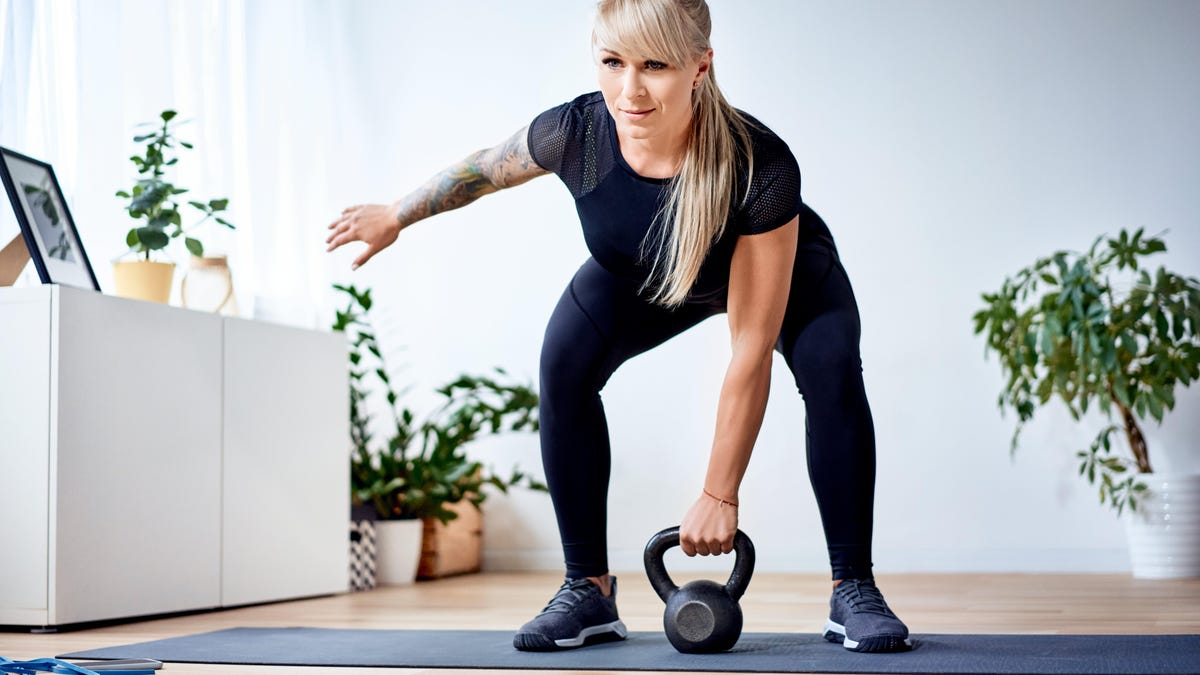
There are a few different styles of kettlebell swinging out there. The video above shows a “hardstyle” swing, which is probably the most common kind you’ll see in American gyms. The action is all in the hips, with the knees barely bending at all. There’s also a sport style swing, which adds a bit of bounce and can be trickier to learn—but it’s still powered from the hips and would still flow nicely with a towel.
Why do so many people recommend light kettlebells for swings?
There’s something important you need to know about kettlebell weight recommendations: they are often based on some completely different lift, rather than a swing.
You’ll sometimes hear people say that women should start with an 8-12 kilogram (18-26 pound) kettlebell and that men should use a bell that weighs 16 kg, or 35 pounds. (Kettlebells are traditionally sold in kilograms, usually in multiples of 4.), Common recommendations are that you should start with a bell you could press overhead three to five times, or that you should use the same kettlebell for both swings and for Turkish getups.
But swings can go heavy. Like, hundreds of pounds heavy. I’ve done swings with a 32 kilogram bell in each hand, meaning the total weight I was swinging was roughly equal to my own bodyweight. You’ll see big guys load up a T-handle with barbell plates when they outgrow the kettlebells that are available to them.
Folks: you don’t need to be able to raise a child above your head multiple times to be able to push them on a swing. For the same reason you should not base your kettlebell swing weight on what you can press or what you can hold overhead.
Coincidentally, a good swing weight for most people will be roughly the same as the weight of a small child. (That said, I can confirm from experience that kettlebells are a more convenient shape for swinging and they do not squirm or scream as much.)
If your main reason for getting into kettlebells is that you want to compete in kettlebell sport or that you want to get really into presses or Turkish getups, then sure, go ahead and start small. But if the main reason you’re getting a kettlebell is so you can swing it—the number one thing a kettlebell is good for—go heavy.
How heavy should a kettlebell be for swings?
If you want to train with kettlebells and can only afford one bell to start with, make it a heavy bell that is appropriately challenging to swing. Can’t press it overhead? That’s fine—train your arms with pushups while you save up for a second, smaller bell.
How big should that swinging bell be? Here’s how I recommend finding a starting point:
- Use a bell that is too heavy to front raise. A front raise is an exercise where you lift a weight up in front of you, to shoulder height, with straight arms. Hold your kettlebell with both hands and attempt to front raise it. If you can, it’s too light for swings.
- Use a bell that is too heavy to press. A kettlebell that you can just barely press for 1-3 reps is about the lightest you should go for swings. A bit heavier would be better.
- Consider a bell that weighs 1/3 of your best deadlift. If you’re experienced with barbell deadlifts, this should give you a nice heavy option for swings. This is probably the heavier end of what you might want to swing, and it’s okay if you’re not ready for that right away.
- Use a bell that you can swing for 10-20 reps or so. I mean, why not just swing some bells and see what you can handle? You can go into a gym or a sporting goods store and just work your way up the rack. Ten to 20 reps isn’t a strict rule, but you should consider a bell that actually challenges you, rather than something you could swing without effort all day.
This last test is what I did to buy my first kettlebell, the day before stores closed for the pandemic lockdown. I could swing a 32 easily, and a 40 with some difficulty. I bought the 40, correctly guessing that I’d grow into it.
Taking these recommendations all together: You want something that is heavy enough that you can’t “cheat” by front raising it, but light enough that you can actually manage to swing it. That gives you a wide range to work with. If you already lift weights, your one-hand press and your barbell deadlift will give you a reasonable range.
Using my current self as an example, that would be anywhere between 20 and 48 kilos. If you’re a beginner, I’d expect a range of 16 to 24 kilos (35 to 53 pounds) would do nicely, and you’d still have room to go heavier from there.

Comentarios recientes